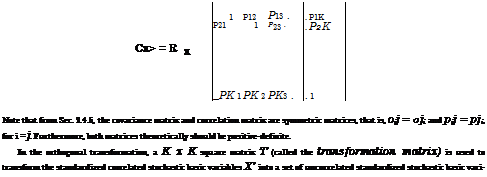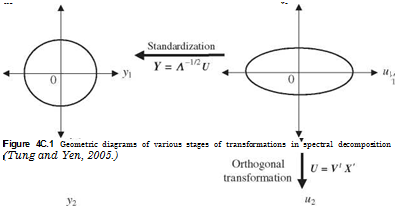Orthogonal Transformation Techniques
The orthogonal transformation is an important tool for treating problems with correlated stochastic basic variables. The main objective of the transformation is to map correlated stochastic basic variables from their original space to a new domain in which they become uncorrelated. Hence the analysis is greatly simplified.

|
|||
|
|||
|
|||
|
|||
|
|
||
|
|||
 |
|||
|
|||
|
|||
|
|||
There are several methods that allow one to determine the transformation matrix in Eq. (4C.2). Owing to the fact that Rx is a symmetric and positive – definite matrix, it can be decomposed into
Rx = LLt (4C.3)
in which L is a K x K lower triangular matrix (Young and Gregory, 1973; Golub and Van Loan, 1989):
|
l11 0 |
0 |
. . . 0 ‘ |
|
l21 l22 |
0 |
. . . 0 |
|
Ik 1 Ik2 Ik3 |
. . . Ikk _ |
|
L |
which is unique. Comparing Eqs.(4C.2) and (4C.3), the transformation matrix T is the lower triangular matrix L. An efficient algorithm to obtain such a lower triangular matrix for a symmetric and positive-definite matrix is the Cholesky decomposition (or Cholesky factorization) method (see Appendix 4B).
The orthogonal transformation alternatively can be made using the eigenvalue-eigenvector decomposition or spectral decomposition by which Rx is decomposed as
Rx = Cx = VAVt (4C.4)
where V is a K x K eigenvector matrix consisting of K eigenvectors as V = (v i, v 2,…, vK), with vk being the kth eigenvector of the correlation matrix Rx, and Л = diag(X1, Л2,…, XK) being a diagonal eigenvalues matrix. Frequently, the eigenvectors v’s are normalized such that the norm is equal to unity, that is, vt v = 1. Furthermore, it also should be noted that the eigenvectors are orthogonal, that is, v t v j = 0, for i = j, and therefore, the eigenvector matrix V obtained from Eq. (4C.4) is an orthogonal matrix satisfying VVt = Vt V = I where I is an identity matrix (Graybill, 1983). The preceding orthogonal transform satisfies
Vt Rx V = Л (4C.5)
To achieve the objective of breaking the correlation among the standardized stochastic basic variables X’, the following transformation based on the eigenvector matrix can be made:
U = VtX’ (4C.6)
The resulting transformed stochastic variables U has the mean and covariance matrix as
|
|
|
|
|
|
As can be seen, the new vector of stochastic basic variables U obtained by Eq. (4C.6) is uncorrelated because its covariance matrix Cu is a diagonal matrix Л. Hence, each new stochastic basic variable Uk has the standard deviation equal to V^k, for all k = 1, 2,…, K.
The vector U can be standardized further as
Y = Л-1/2и (4C.8)
Based on the definitions of the stochastic basic variable vectors X – (vx, Cx), X’ – (0, Rx), U – (0, Л), and Y – (0,1) given earlier, relationships between them can be summarized as the following:
Y = Л-1/2и = Л-1/2 V1X’ (4C.9)
Comparing Eqs.(4C.1) and (4C.9), it is clear that
T-1 = Л-1/2 V1
Applying an inverse operator on both sides of the equality sign, the transformation matrix T alternatively, as opposed to Eq. (4C.3), can be obtained as
T = VЛ1/2 (4C.10)
Using the transformation matrix T as given above, Eq. (4C.1) can be expressed as
X ‘ = TY = VЛ1/2Y (4C.11a)
and the random vector in the original parameter space is
X = vx + D1/2 VЛ1/2Y = vx + D1/2 LY (4C.11b)
Geometrically, the stages involved in orthogonal transformation from the originally correlated parameter space to the standardized uncorrelated parameter space are shown in Fig. 4C.1 for a two-dimensional case.
From Eq. (4C.1), the transformed variables are linear combinations of the standardized original stochastic basic variables. Therefore, if all the original stochastic basic variables X are normally distributed, then the transformed stochastic basic variables, by the reproductive property of the normal random variable described in Sec. 2.6.1, are also independent normal variables. More specifically,
X – N(vx, Cx) X’ – N(0, Rx) U – N(0, Л) and Y = Z – N(0,1)
The advantage of the orthogonal transformation is to transform the correlated stochastic basic variables into uncorrelated ones so that the analysis can be made easier.

The orthogonal transformations described earlier are applied to the standardized parameter space in which the lower triangular matrix and eigenvector matrix of the correlation matrix are computed. In fact, the orthogonal transformation can be applied directly to the variance-covariance matrix Cx. The lower triangular matrix of Cx, L, can be obtained from that of the correlation matrix L by
L = D1/2 L (4C.12)
Following a similar procedure to that described for spectral decomposition, the uncorrelated standardized random vector Y can be obtained as
Y = Л-1/2 Vг (X – цх) = Л-1/2£7 (4C.13)
where V and Л are the eigenvector matrix and diagonal eigenvalue matrix of the covariance matrix Cx satisfying
Cx = УЛ V/1
and U is an uncorrelated vector of the random variables in the eigenspace having a zero mean 0 and covariance matrix Л. Then the original random vector X can be expressed in terms of Y and L:
X = fix + VA1/2Y = fix + L Y (4C.14)
One should be aware that the eigenvectors and eigenvalues associated with the covariance matrix Cx will not be identical to those of the correlation matrix Rx.






Leave a reply